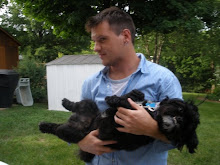Okay, the subject matter itself might not be anything particularly earth-shattering, but I found the process pretty fascinating and entertaining myself. As I explained before, instead of hiring a product photographer at an obscene rate to turn in pre-edited photos dropped out on white, we paid a portrait photographer his session rates (much, much cheaper) for photos shot on a white-paper background. Then, all I had to do was learn Photoshop to clip the product out myself. Yes, I had to learn Photoshop at age 24. I'm officially the worst computer nerd ever.
In the last post, I showed you the finished product that we got from our photo sessions. This time, I'm going to show you how we got those photos. For smaller product, we used a light-softening white nylon tent, pictured below:
By placing a stand underneath the tent, we could raise the product enough to give the product a white base. We shined a bright true-white spotlight from behind and into the tent, illuminating the back without shadowing the front of the product. We also used warmer (reddish) flashbulb lights on both sides of the tent, casting a soft, shadow-free glow on the product. Unfortunately, our nylon tent was heavily wrinkled from months of improper storage, so even after considerable ironing, we had some refracted light and anomalies in our background. Nothing a little Photoshop can't fix, but it's still a bit annoying to look at in our raw photos:
Before I forget, I would also like to mention something about glass. Glass by itself is very hard to photograph with the lighting required to whiten the background. The glass absorbs the light from all angles and basically becomes transparent without a very low exposure. To counteract this, you can place large black objects or sheets of paper on either side, just outside of the photograph itself. This will create black outlines like you see on the glass above. These colored glasses didn't need it so much, but clear glass just looks so much better with darker outlines. The opposite approach is to use a black background to make the glass stand-out with white outlines which tends to look more elegant. Because we're photographing for the web, and have a true white background, sadly, this wasn't an option.
All of those photographs of standing items that show the background will require heavy clipping to remove the phantom waves caused by wrinkles in the backdrop. Fortunately, for the smaller items that required a top-down shot, the tent still resulted in almost perfect photos without editing:
Our mounted racks and floor racks required additional space, so we unfurled an enormous sheet of white paper with about 8 feet of floor length, placed a foil sheet to reflect light up into the glass bottles, and positioned two spotlights aimed at the background behind the racks:
This gave us a true-white background and eliminated most of the shadows on the ground. However, we were unable to correct the warm light effect around the racks, giving us a slightly pink/tan gradient towards the bottom of the rack. I've been having to clip out the bottom half of almost every rack:
This picture also brings up an amusing point; since we couldn't mount the mounted racks in the studio, I had to hold up each one up while touching it as little as possible, then photoshop myself out of the picture. Good times...
All of this I've learned as it happened. I'm having a lot of fun figuring out all these different lighting effects, exposures, and background options. If you've got any tips for me to make my next shoot go easier, or for anyone in general, leave me a comment. I'm always looking for advice!
Josh
Listened during this post: Spotlight by Tom P, Himitsu by Tujiko Noriko, Ox-Eye by Jeniferever, Losing Out (Ft. Royce Da 59") by Black Milk, Let Me Go by Brittany Street, Brick Eyes by Garland of Hours, Polygraph Right Now by The Spill Canvas, Mare Mortis by The Appleseed Cast, Handshake Drugs by Wilco







No comments:
Post a Comment